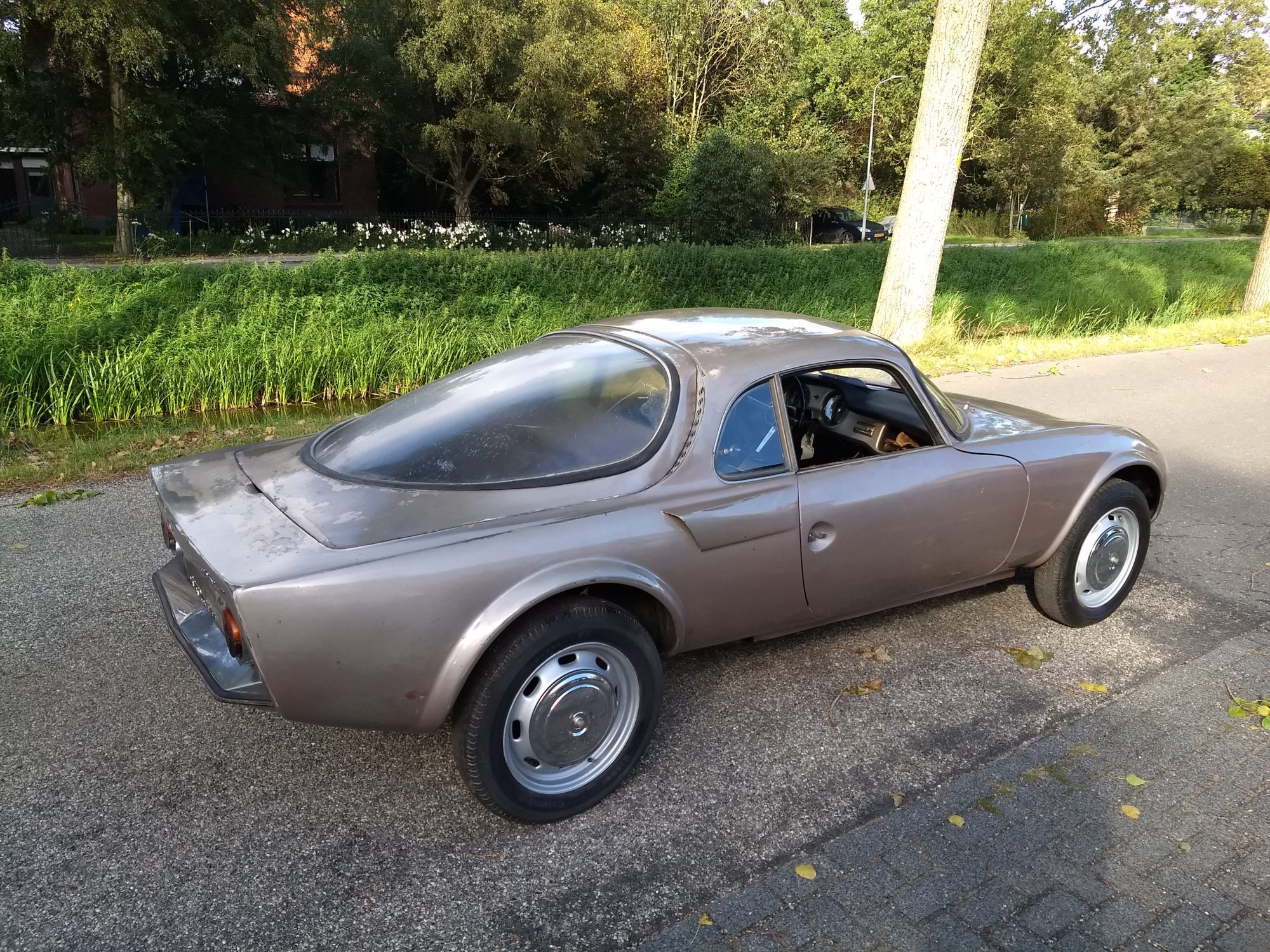What is in a name? Shakespeare already wondered. The Matra Djet was also known as Matra Bonnet Djet, Matra Sports Djet and Matra Sports Jet. The binding factor was René Bonnet. But no matter what name you put on it, the discovery by André Kout, the man behind Kout Automobiles from the Wieringerwaard area just below the polar circle, is no less unique.
René Bonnet. He started making sports cars under the Deutsch et Bonnet flag
But as often happens within relationships, the collaboration with Charles Deutsch came to an end. René Bonnet started out as Automobiles René Bonnet in a hall rented from Matra. And because 'jet engines' at that time stood for the highest technical speed possible, he came up with the name 'Djet' that is easier for the French to pronounce.
The creation was supported by a tubular frame under a polyester cover supplied by Matra
The centrally placed engine on the Matra Djet was a Renault R8 block that was built on a gearbox (with changed gear ratios) of a Renault Relay van. With independent wheel suspensions and disc brakes all around, the car - the little car - was optically and technically a thoroughbred sportsman, a two-person ADHd weighing only 600 kilos.
In the first part of the Matra Djet history there were three versions
The René Bonnet Djet had the 65 hp block from the R8 Major and trotted 165 km / h with it. Successor René Bonnet Djet II had an R8 Gordini engine of 80 hp and was 190 km / h fast. The René Bonnet Djet III was conceived purely for circuit use and equipped with a 998 cc DOHC block
Small businesses, big problems
Driven technicians, artists and other talents are often mentally retarded when it comes to commercial thinking. So too Bonnet. So it also went wrong with the pennies or let it have been Francs. But at that time, Matra felt that it might be interesting to dive into the sports car world in terms of prestige and gain. After some administrative tampering, Bonnet left the building somewhat sadly.
Because Matra had taken over the rights and production of his brainchild. That was in 1964. The production of the primeval Djet was stopped, after which the designer Philippe Guèdon, who was taken away from Simca, improved the design on many points. The car became a car. He became bigger, wider, higher and (around 50+ kilos) heavier.
Under a different flag
In April 1965, production was restarted under the Matra banner with two new versions, the Matra Bonnet Djet V (with a Renault 8 Major block) and Djet VS (with a Renault 8 Gordini four-cylinder). After the Salon de l'Auto in Paris in 1965, the Roman numerals and the Bonnet name were dropped, the car was renamed Matra Sports Djet 5 from then on.
In 1966 a model with a larger Gordini engine came on the market and the Djet name was replaced by the originally intended Jet. The series now consisted of the Matra Sports Jet 5 (1108 cc-Renault 8 Major engine), Jet 5 S (1108 cc-Renault 8 Gordini engine) and Jet 6 (1255 cc-Renault Gordini engine).
A total of three types of the Matra Djet / Jet were produced from 1965 to 1967.
- Matra Bonnet Djet V / Matra Sports Djet 5 / Jet 5 with an 1108 cc Renault 8 Major engine, 70 SAE hp, and a top of 170 km / h
- Matra Bonnet Djet VS / Matra Sports Djet 5S / Jet 5S, with 1108 cc Renault 8 Gordini block, 90 SAE hp, top speed 190 km / h
- Matra Sports Jet 6 with a 1255 cc Renault 8 Gordini engine, 105 SAE hp, with a top speed of 210 km / h
Apart from these model designations, 'De Luxe' versions were available, with a wooden instrument panel, wooden steering wheel, different placement of instruments and handbrake and a larger bumper.
No salesmen
In 1965 people dreamed about a production of 3000 Jets before 1967, but dreams are deception. In 1967, production stopped with a total of 1495 Matra (D) Jets produced. And in 1968 there were quite a few unsold in showrooms there.
This Matra Djet
The 1966 Matra Djet 5 did not immediately weigh the stated 740 kilos when it was found. There was therefore everything on and in. Even the dust layer weighed in. On the plus side: there was no block and bin in it. But the car is completely honest and untouched. The chassis is in good condition and the body has only been painted once and is therefore sleek. There is a very small damage on the nose. We have never seen such a forgotten, but original Matra Djet. All original details are present and it has never been restored.









Totally agree Dolf.
Just like in music disciplines, try to approach the original, master yourself, then equal, and then give your own personal idea and original concept even more of its own “cachet” and further develop it. L, Histoire, se repete. Nothing wrong with that.
Sorry Dolf for the spelling mistake maarmeens. Should be: once, just like… etc.
Just a correct language and spelling “freak”.
Nobody is perfect.
Rest my case.
Greetings!
Strange, but true (or not), Dolf.
As I read this article from you and see the accompanying photos, I immediately get a kind of “flashback” to and from the then marketed Opel GT.
This kind of Opel design released as a “mini Chevrolet Corvette”, intended for the European market as a “mini” GT (Grand Tourismo) Super Macho Sports car model, seems to me like a sort of plagiarism.
Probably just as the former Eastern bloc, including the former USSR, also imitated the then famous Space Shuttle in the form of the Boeran and also the Concorde, Mach 2+ reconstructed with disastrous consequence, by deliberately wrong blueprints through and during all that Cold War espionage activities by spooning to the then KGB. Rest my case.
Well… Doesn't the old adage say: "Better stolen than badly conceived"
Totally agree Dolf.
Just like in music disciplines, try to approach the original, master yourself, then equal, and then give the personal idea and original concept even more of its own “cachet” and further develop it. L, Histoire, se repete. Nothing wrong with that.
Unfortunately Alfredo, the Djet dates back to 1962. The Opel GT looks a bit like the Corvette C3 that came out in 1968. The Opel GT was also released in 1968, so the Djet had already been on the market for 6 years. So fill in the basis of this model.